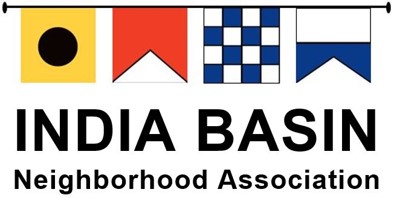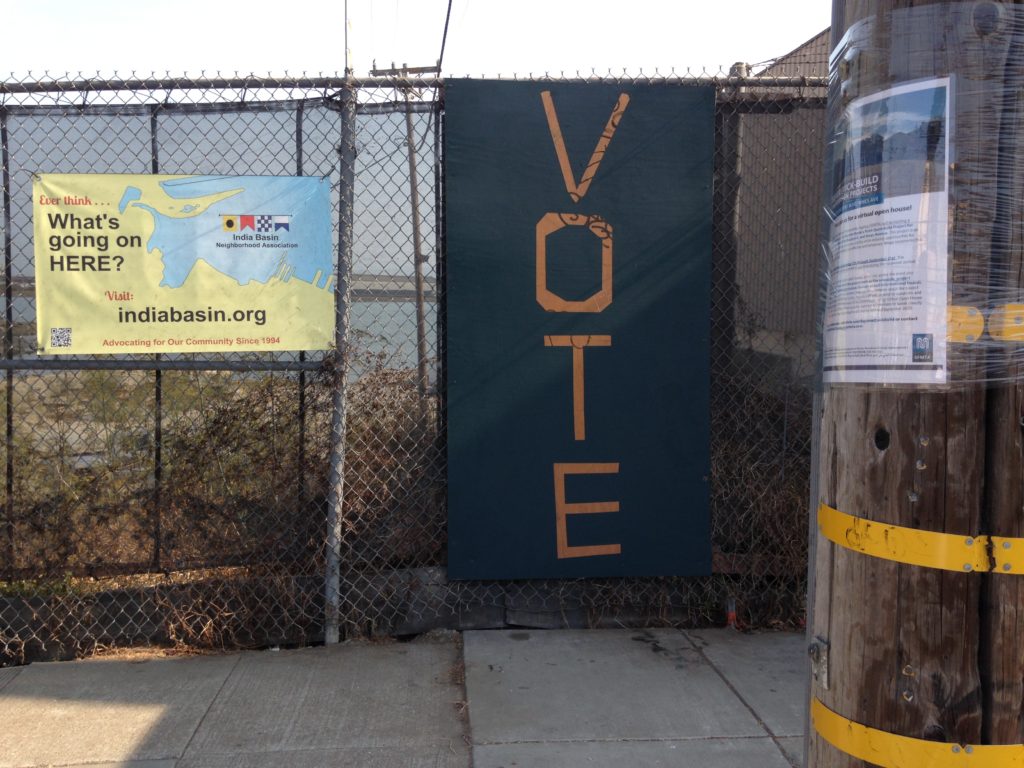IBNA has a long commitment to the Historic Boatyard and 900 Innes becoming a park. In 1999 IBNA members conceived a large a waterfront park in our community as part of the Recreation and Parks Department “Dream Park” planning process and has continued to lead the effort to make the Shipwrights Cottage San Francisco Landmark #250, acquire the Historic Boatyard, and develop the park ever since.
Since 2014, the San Francisco Recreation and Park Department (RPD) has owned the Historic Boatyard east of Innes and Griffith: 1.5 acres of waterfront land, an additional 1.83 acres underwater, and the Shipwright’s Cottage at 900 Innes.
The land is undergoing two processes, park design and environmental cleanup.
Park Design of Historic Boatyard
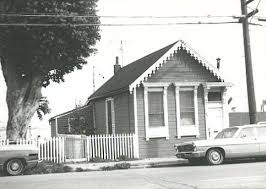
The historic boatyard at 900 Innes is not just any park land. Once the centerpiece of wooden boatbuilding in Northern California, this boatyard specialized in scow schooners. In the days before trucks and bridges, scow schooners were vital for taking manufactured goods to the central valley and bringing produce and hay from farmlands into San Francisco. Boats built here include the Alma, now a National Historic Landmark, and Jack London’s Snark.
Still a private business, during World War II, low-draft boats called Victory Launches were built here for deployment to the Pacific theater. IBNA strives to honor the contribution to California history made by the union shipwright’s working at 900 Innes from 1860 into the 1990s.
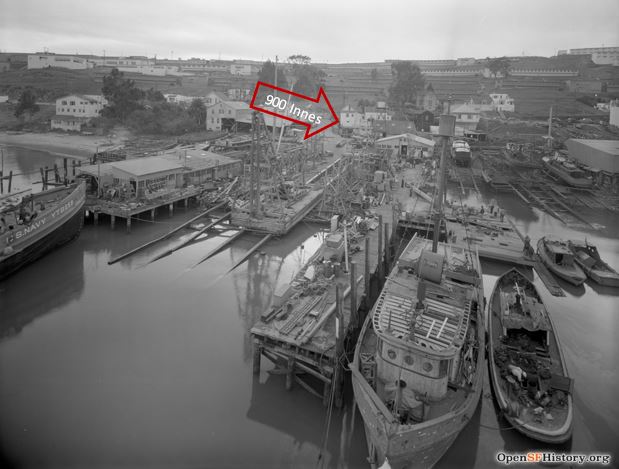
The historic boatyard is Phase 1 of the India Basin Park design proposed by landscape architects Gustafson Guthrie and Nichol (GGN) of Seattle, Washington. Phase 2 is a complete destruction, new design, and rebuild of the existing India Basin Shoreline Park.
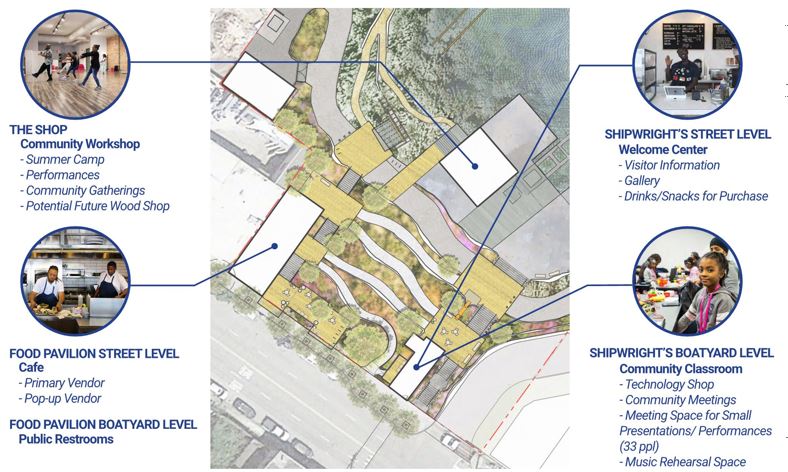
Proposed Phase 1 features include restoration of the Shipwright’s Cottage into a café and restroom; building an approximately 25-foot wide “food pavilion” business on Innes Avenue; building an approximately 24-foot wide roofed “front porch” on Innes Avenue for gatherings; creating a path from Innes Avenue to the water; building an event pavilion, maintenance building, and floating dock; and adding wetlands. There is a recreational bike path that takes riders along the Bay Trail. Phase 1 is scheduled to be completed by Spring 2022.
Learn more about the design: https://bcdc.ca.gov/drb/2020/0210-900-Innes-Exhibits.pdf
Environmental Cleanup of Historic Boatyard
June 2020 UPDATE: The 900 Innes Remediation Project is out to bid. Environmental cleanup will last several months. The project involves removing all wharves and structures except the Shipwright’s Cottage and contaminated soils and sediment across the site to meet Water Board- and EPA-approved cleanup targets, backfilling the site with clean soil and sediment, capping two mudflat areas with sand, and constructing an interim public access pathway. Approximately 2,500 truck trips are planned to remove and replace these materials and soil. The estimated cost is $7,000,000.
Funding for the 900 Innes remediation project is made possible by a number of state and federal grants including a $4.99MM grant award from the San Francisco Bay Restoration Authority, $748,204 from the USEPA Brownfields Program, and $1.2MM from the USEPA Water Division.
IBNA Concerns on Environmental Cleanup: IBNA questioned RPD about some aspects of their environmental cleanup plan and is pleased to show their responses:
IBNA QUESTION: Could RPD use barges rather than trucks to move some of the materials in and out of the site? Neighbors are especially concerned about the noise, pollution, and traffic safety impact from the estimated 2,500 truck trips in and out of the site during this cleanup.
RPD ANSWER: The site conditions do not allow for this work performed from a barge scow. Anchor QEA affirmed that barge dredging does not work in this location given the majority of the dredging is nearshore. We addressed the water depths and surveys in the RAP public meeting as being too shallow. Anchor QEA has noted that even the smallest barge, a pocket barge, still has a 10 ft draft. The bathymetric surveys show that cove is too shallow during low and negative tides (where there’s no water), and that makes work from barges infeasible.
The Water Board Case Officer addressed in the RTCs that the previous Operator dredged a channel and utilized this for many years for their work. That channel has filled in and dredging a new channel would not be palatable to the Resource Agencies: it creates more dredge spoils, re-exposes previous contamination that has since been covered by natural accretion making the cost excessive. Slurrying the material through to an even further offshore barge was considered, but it would not allow for the proper handling of wastewater and effluent discharges. Even though it came from the Bay you are not allowed to put it back in or what they call “overflow back” form the barge. Because of the comments received during the Water Board meeting, we researched options to reduce truck trips. Essentially, we have asked Contractors to utilize a nearby quarry for backfill source material and find landfill sites in close proximity for the disposal of those materials. We were able to reduce the trips as the trucks are removing material and returning with imported material would not cycle empty. Similarly, with any park improvements, or with home renovations, these projects will have inconveniences and temporary impacts
IBNA QUESTION: What are the planned transportation routes if not all materials can be moved via barge? Can you consider Hudson to Hunters Point Boulevard, which was the route used when it was a working boatyard?
RPD ANSWER: Hudson to Hunters Point Blvd is the primary route because it is less steep, though the Contractor will have access to Griffith as needed.
IBNA QUESTION: Are there any air-quality and noise impacts expected to nearby businesses and homes?
RPD ANSWER: The project is required to comply with the City’s Dust Control Ordinance and Noise Ordinance for construction and those requirements will be enforced. We also have an abundance of mitigation measure requirements that limit vibration on site due to the Shipwrights Cottage.
IBNA QUESTION: Will there be any street closures or parking restrictions, and will there be any traffic control personnel (say for trucks making turns in and out of the yard)?
RPD ANSWER: The Contractor will need to provide a plan for haul routes, and would need to provide traffic control measures, and flaggers are standard. We don’t believe there is any need for street closures, as the work is essentially self-contained. There may be sidewalk closures in front of the property to ensure work can be performed on the Cottage. The Contractor will be required to pull the necessary permits from BSM.
IBNA QUESTION: Will there be any use restrictions on the adjacent India Basin Shoreline Park, India Basin Open Space, and the Bay (for example for boating or fishing)?
RPD ANSWER: The excavation/demolition work would be done behind a water barrier/dam so there are no impacts to receiving waters from dredging activities. This particular project is not creating any restrictions to Bay access from Shoreline Park or India Basin Open Space. USFWS, NOAA Fisheries, CDFW and BCDC did not feel there were any impacts to warrant restrictions and therefore did not impose any required closures of any other facilities.
IBNA QUESTION: How is RPD dealing with the utility poles (and lines) currently on site and along Innes Avenue?
RPD ANSWER: Utility poles on Innes Avenue will remain. There are utility poles within the property that served the operator historically and those will be removed, but they are not serving any of the adjacent residents and businesses. The utility poles along Innes Ave in front of the 900 Innes and Cottage are remaining for the indefinite future unless the City or PG&E have plans for undergrounding those lines.
IBNA QUESTION: Can RPD provide information to neighbors about work hours?
RPD ANSWER: They would be required to work within the hours allowed by the Noise Ordinance which is 7am-8pm. The scale of the project is small, and I do not foresee the Contractor working with multiple shifts that would require them working until 8pm. Typically, with RPD projects the Contractors complete their workday by 3pm or 4pm when starting at 7am.
Learn more about the environmental cleanup: https://www.bcdc.ca.gov/cm/2020/0416-San-Francisco-Recreation-Parks-India-Basin-Remediation-2019.003.00.pdf
IBNA is closely following both the environmental cleanup and the park design and will advise members of updates and opportunities for public input.
Questions or Additions
The India Basin Neighborhood Association welcomes questions, corrections, or additions about any of the projects mentioned here: Use the Contact Form
